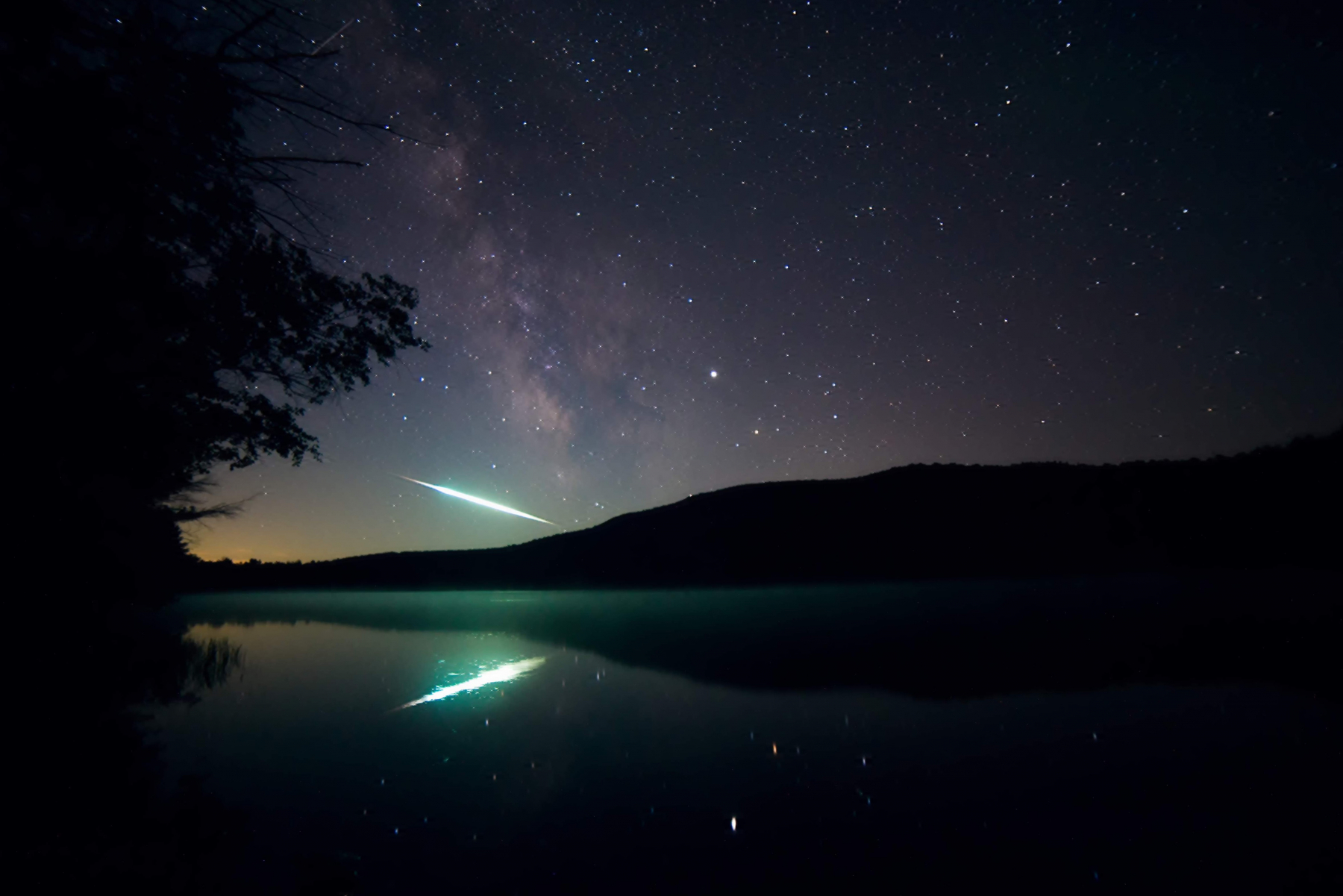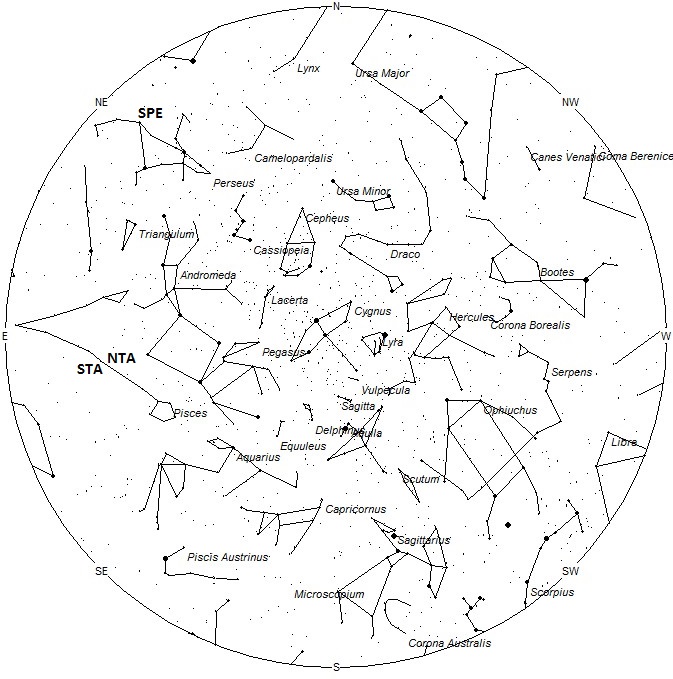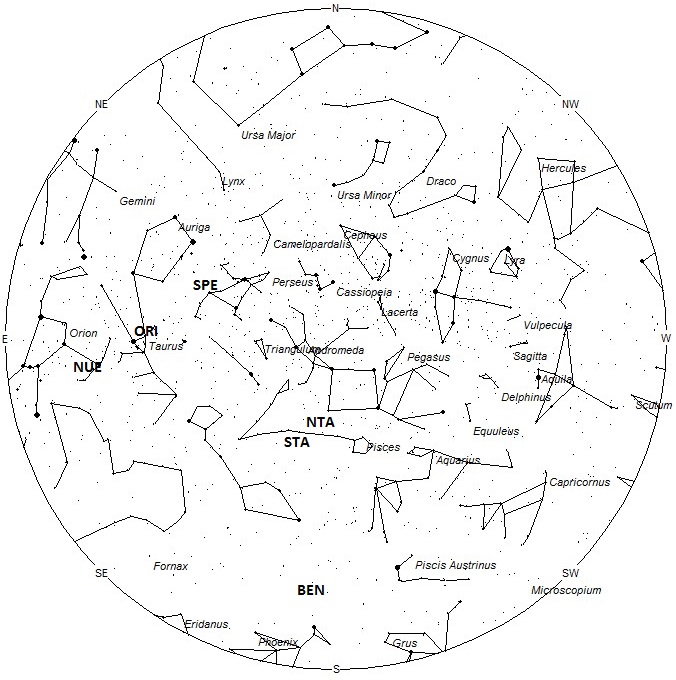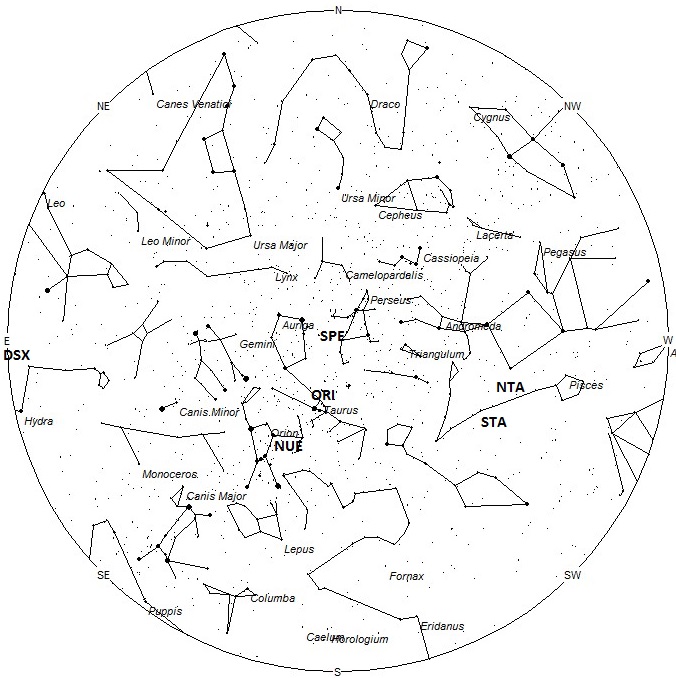
During this period the moon reaches its last quarter phase on Saturday September 21st. At this time the half-illuminated moon will rise near 23:00 local daylight saving time (LDST) and will remain in the sky the remainder of the night. Successful meteor observations can be obtained by simply viewing in a direction with the moon at your back. The moon will become less of a problem with each successive night as its phase wanes and it rises later in the morning. The evening sky is unaffected by moonlight but still produces less activity than the morning hours. The estimated total hourly meteor rates for evening observers this week is near 3 for those viewing from the southern hemisphere and 4 for those located north of the equator. For morning observers the estimated total hourly rates should be near 13 as seen from mid-northern latitudes (45N) and 8 as seen from tropical southern locations (25S). The actual rates will also depend on factors such as personal light and motion perception, local weather conditions, alertness and experience in watching meteor activity. Morning rates are reduced during this period due to moonlight. Note that the hourly rates listed below are estimates as viewed from dark sky sites away from urban light sources. Observers viewing from urban areas will see less activity as only the brightest meteors will be visible from such locations.
The radiant (the area of the sky where meteors appear to shoot from) positions and rates listed below are exact for Saturday night/Sunday morning September 21/22. These positions do not change greatly day to day so the listed coordinates may be used during this entire period. Most star atlases (available at science stores and planetariums) will provide maps with grid lines of the celestial coordinates so that you may find out exactly where these positions are located in the sky. A planisphere or computer planetarium program is also useful in showing the sky at any time of night on any date of the year. Activity from each radiant is best seen when it is positioned highest in the sky, either due north or south along the meridian, depending on your latitude. It must be remembered that meteor activity is rarely seen at the radiant position. Rather they shoot outwards from the radiant so it is best to center your field of view so that the radiant lies at the edge and not the center. Viewing there will allow you to easily trace the path of each meteor back to the radiant (if it is a shower member) or in another direction if it is a sporadic. Meteor activity is not seen from radiants that are located below the horizon. The positions below are listed in a west to east manner in order of right ascension (celestial longitude). The positions listed first are located further west therefore are accessible earlier in the night while those listed further down the list rise later in the night.
These sources of meteoric activity are expected to be active this week.
Veteran observer Tim Cooper has alerted us to the possibility of meteor activity produced by the asteroid 101955 Bennu from September 22-26. The radiant is expected to be near the position of 00:20 (005) -34. This position lies in central Sculptor, 15 degrees southwest of the 2nd magnitude star known as Diphda (beta Ceti). This area of the sky also lies 8 degrees north of 2nd magnitude star Ankaa (alpha Phoenicis). The radiant is best placed near 01:00 LDST, when it lies highest above the horizon. Southern observers are better situated for viewing this activity as the radiant will lie much higher in their sky. Rates are expected to be low or nonexistent but any observers of this source should report their efforts even if no activity is seen. With an entry velocity of 6 km/sec., activity from this radiant would be very slow.
We are now encountering inbound debris from comet 2P/Encke, which has a radiant superimposed upon the anthelion radiant. Since it has been shown that meteors from 2P/Encke are more numerous we will recognize this activity as the Taurids. There are two distinct radiants for the Taurids. The activity profile for the Southern Taurids is unusual in that there are several peaks and valleys throughout the activity period. The difference between the peaks and valleys is not great, but definitely noticeable in video data. These peaks occur near October 10, October 29 through November 3, and near November 15th. After this last peak activity slowly wanes and eventually disappears by Christmas. The Northern branch reaches maximum near November 3rd and remains in a plateau-like peak for about 10 days. After November 12th activity slowly wanes and disappears about a week before Christmas. See the charts and table below for positions of these radiants.
The September Epsilon Perseids (SPE) are active from September 3 through October 3 with the peak occurring on September 11th. The radiant is currently located at 04:06 (062) +41. This position lies in eastern Perseus, 2 degrees northeast of the 3rd magnitude star known as epsilon Persei. The radiant is best placed near 0400 LDST, when it lies highest above the horizon. Rates are expected to be near 1 as seen from the northern hemisphere and less than 1 as seen from south of the equator. With an entry velocity of 65 km/sec., most activity from this radiant would be swift.
The Orionids (ORI) should begin to appear during this period from a radiant located at 04:20 (065) +17. This area of the sky lies in central Taurus, 3 degrees northwest of the 1st magnitude orange star known as Aldebaran (alpha Tauri). The radiant is best placed near 0400 LDST, when it lies highest above the horizon. Current hourly rates would be near 1 per as seen from the northern hemisphere and less than 1 as seen from south of the equator. With an entry velocity of 67 km/sec., most activity from this radiant would be of swift speed.
The nu Eridanids (NUE) were co-discovered by Japanese observers using SonotoCo and Juergen Rendtel and Sirko Molau of the IMO. Activity from this long-period stream stretches from August 24 all the way to November 16. Maximum activity occurs on September 24th. The radiant currently lies at 05:00 (075) +06, which places it in western Orion, 2 degrees southeast of the 3rd magnitude star known as Tabit (pi3 Orionis). This area of the sky is best seen during the last dark hour before dawn when the radiant lies highest in a dark sky. Current rates are expected to be near 1 per hour during this period no matter your location. With an entry velocity of 67 km/sec., the average meteor from this source would be of swift velocity.
The Daytime Sextantids (DSX) are not well known due to the fact that the radiant lies close to the sun and these meteors are only visible during the last couple of hours before dawn. The radiant is currently located at 9:51 (148) +01. This position lies in western Sextans, 3 degrees northeast of the 4th magnitude star known as Ukdah (iota Hydrae). This area of the sky is best placed in the sky during the last hour before dawn, when it lies highest above the horizon in a dark sky. Current rates would be most likely less than 1 per hour no matter your location. Spotting any of this activity would be a notable accomplishment. With an entry velocity of 33km/sec., most activity from this radiant would be of medium-slow speed.
As seen from the tropical southern latitudes (25S), one would expect to see approximately 6 sporadic meteors per hour during the last hour before dawn as seen from rural observing sites. Evening rates would be near 2 per hour. As seen from mid-northern hemisphere (45N), morning rates would be near 8 per hour as seen from rural observing sites and 3 per hour during the evening hours. Locations between these two extremes would see activity between the listed figures. Morning rates are reduced during this period due to moonlight.
The list below offers the information from above in tabular form. Rates and positions are exact for Saturday night/Sunday morning except where noted in the shower descriptions.
| SHOWER | DATE OF MAXIMUM ACTIVITY | CELESTIAL POSITION | ENTRY VELOCITY | CULMINATION | HOURLY RATE | CLASS |
| RA (RA in Deg.) DEC | Km/Sec | Local Daylight Saving Time | North-South | |||
| 101955 Bennu (BEN) | Sep 25 | 00:20 (005) -34 | 6 | 01:00 | ? | III |
| Northern Taurids (NTA) | Nov 03 | 00:26 (007) +10 | 28 | 01:00 | 1 – <1 | II |
| Southern Taurids (STA) | Oct 10 | 00:46 (011) +03 | 27 | 01:00 | 1 – <1 | II |
| September Epsilon Perseids (SPE) | Sep 11 | 04:06 (062) +41 | 65 | 04:00 | 1 – <1 | II |
| Orionids (ORI) | Oct 22 | 04:20 (065) +17 | 67 | 04:00 | 1 – <1 | I |
| nu Eridanids (NUE) | Sep 24 | 05:00 (075) +06 | 67 | 05:00 | 1 – 1 | IV |
| Daytime Sextantids (DSX) | Sep 29 | 09:51 (148) +01 | 33 | 10:00 | <1 – <1 | IV |
 American Meteor Society
American Meteor Society



Looking southwest in Arlington, TX at approximately 9.40pm, I saw a very bright meteor just above the treeline. One of the brightest uve ever seen.
I just saw a bright blue/green meteor in Berlin, it fractured to a few pieces before disappearing behind the rooftops in my courtyard! It was amazing!
I saw an amazing bright orange, blue and white light streak down the sky and get larger with what was like a white explosion surrounded by red and orange… one of the most beautiful things I have ever seen in my life Sept 2019
Hi all, In July 2019 I was at Area 51 and it was black night, no moon. At about 1am I saw this massive green ball of light descend to the earth about 4 miles from Black Mail Box on Hwy 375. It didn’t even look like a falling star because it was rather slowly coming to earth. I didnt have my camera set up in that direction so I missed it. I am always at Area 51 shooting every 2 weeks.. creepy out there.
Tony Phillips (2000). “June’s Invisible Meteors”. NASA. Archived from the original on November 2, 2007. Retrieved September 7, 2007 .